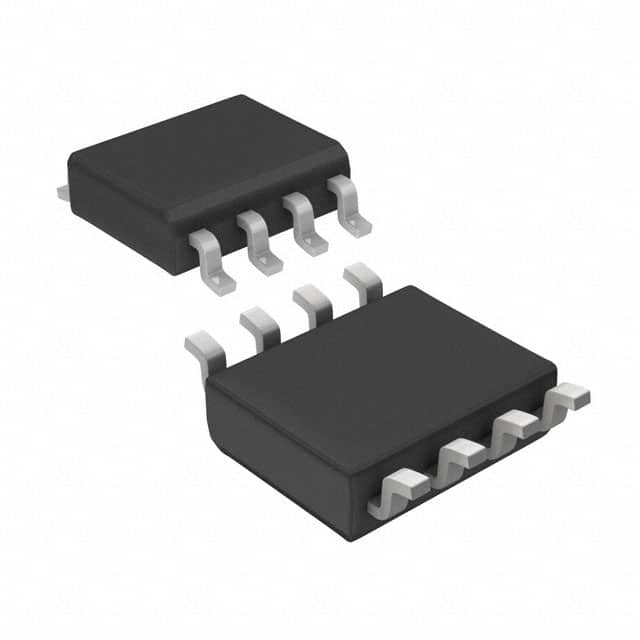Lihat spesifikasi untuk detail produk.

TS941BID
Product Overview
Category
TS941BID belongs to the category of integrated circuits (ICs).
Use
The TS941BID IC is commonly used in electronic devices for signal amplification and switching purposes.
Characteristics
- The TS941BID is a low-power quad operational amplifier.
- It operates on a single power supply voltage ranging from 2.7V to 5.5V.
- This IC offers rail-to-rail input and output capabilities.
- It has a high gain bandwidth product and low input offset voltage.
- The TS941BID is designed for low noise and low distortion applications.
Package
The TS941BID is available in a small outline package (SOIC) with eight pins.
Essence
The essence of the TS941BID lies in its ability to provide accurate amplification and switching functions while consuming minimal power.
Packaging/Quantity
The TS941BID is typically sold in reels or tubes, with each reel/tube containing a specific quantity of ICs. The exact packaging and quantity may vary depending on the supplier.
Specifications
- Supply Voltage Range: 2.7V to 5.5V
- Input Offset Voltage: ±1mV (maximum)
- Gain Bandwidth Product: 1MHz (typical)
- Slew Rate: 0.6V/μs (typical)
- Input Bias Current: 1pA (typical)
- Operating Temperature Range: -40°C to +125°C
Detailed Pin Configuration
The TS941BID IC has eight pins arranged as follows:
- Non-Inverting Input (A+)
- Inverting Input (A-)
- Output (AOUT)
- VCC+
- Inverting Input (B-)
- Non-Inverting Input (B+)
- Output (BOUT)
- VCC-
Functional Features
- Low power consumption
- Rail-to-rail input and output capability
- High gain bandwidth product
- Low input offset voltage
- Low noise and distortion
- Wide operating temperature range
Advantages and Disadvantages
Advantages
- Low power consumption makes it suitable for battery-powered devices.
- Rail-to-rail input and output capability allows for accurate signal amplification.
- High gain bandwidth product ensures efficient signal processing.
- Low input offset voltage enables precise measurements.
- Low noise and distortion contribute to high-quality audio/video applications.
Disadvantages
- Limited supply voltage range may restrict its use in certain applications.
- Slew rate may be slower compared to some alternative models.
Working Principles
The TS941BID operates as a quad operational amplifier, which means it contains four independent amplifiers within a single IC package. Each amplifier can amplify an input signal and provide an output signal with minimal distortion. The rail-to-rail input and output capability allows the IC to handle signals that span the entire supply voltage range. This feature is particularly useful when dealing with low-voltage signals.
Detailed Application Field Plans
The TS941BID finds application in various fields, including but not limited to: - Audio amplification circuits - Sensor signal conditioning - Battery-powered devices - Portable instrumentation - Active filters - Signal switching circuits
Detailed and Complete Alternative Models
Some alternative models to the TS941BID include: - LM324 - TL074 - MCP6004 - AD8620
These alternatives offer similar functionality and can be used as substitutes depending on specific requirements.
In conclusion, the TS941BID is a low-power quad operational amplifier that provides accurate amplification and switching functions. Its rail-to-rail input and output capability, along with other features, make it suitable for various applications. However, it is important to consider alternative models based on specific needs and requirements.
Sebutkan 10 pertanyaan dan jawaban umum terkait penerapan TS941BID dalam solusi teknis
Sure! Here are 10 common questions and answers related to the application of TS941BID in technical solutions:
Q: What is TS941BID? A: TS941BID is a specific model or type of technical solution used in various applications.
Q: What are the main features of TS941BID? A: The main features of TS941BID include [list the main features].
Q: In which industries can TS941BID be applied? A: TS941BID can be applied in industries such as [list relevant industries].
Q: How does TS941BID improve technical solutions? A: TS941BID improves technical solutions by [explain how it enhances performance, efficiency, etc.].
Q: Can TS941BID be integrated with existing systems? A: Yes, TS941BID can be integrated with existing systems through [describe integration methods].
Q: What are the potential challenges when implementing TS941BID? A: Some potential challenges when implementing TS941BID may include [mention possible challenges].
Q: Are there any specific requirements for using TS941BID? A: Yes, there may be specific requirements such as [list any necessary hardware, software, or infrastructure].
Q: How does TS941BID contribute to cost savings? A: TS941BID contributes to cost savings by [explain how it reduces expenses, optimizes resources, etc.].
Q: Can TS941BID be customized for specific needs? A: Yes, TS941BID can be customized to meet specific needs through [describe customization options].
Q: Is training required to use TS941BID effectively? A: Yes, training may be required to use TS941BID effectively. [Mention any training programs or resources available].
Please note that the specific questions and answers may vary depending on the context and application of TS941BID in technical solutions.

